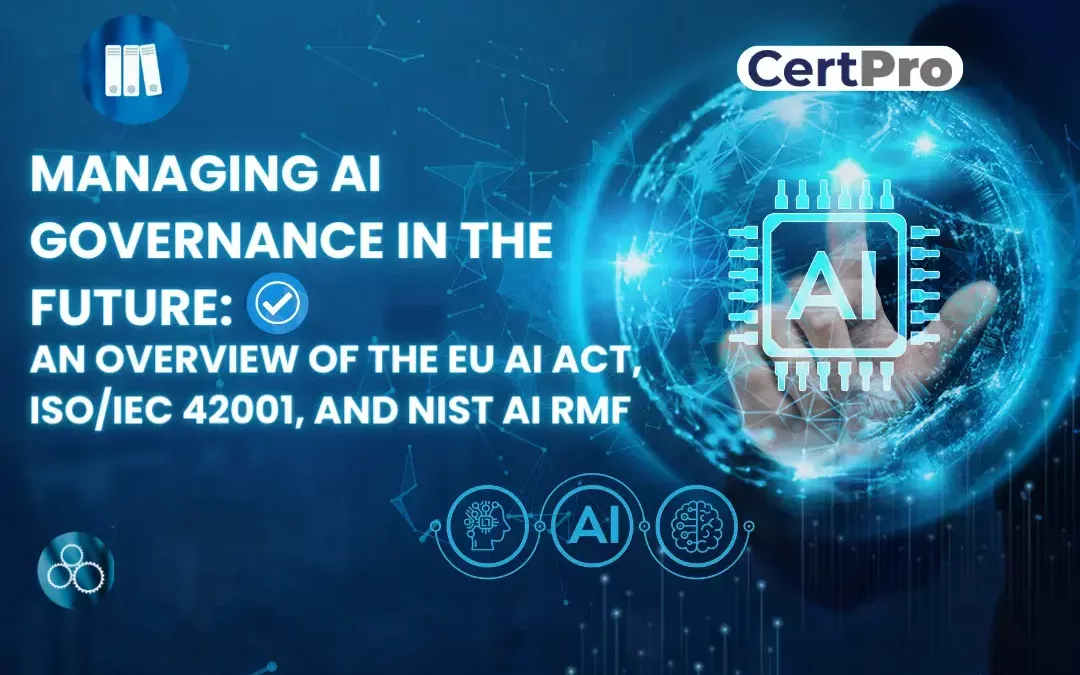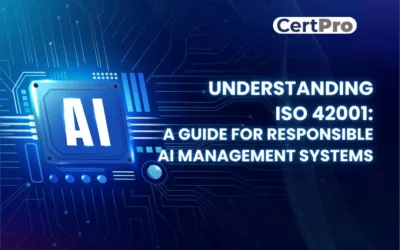Artificial intelligence(AI) has become a part of our lives and professions. It promises unparalleled ethical implications in risk management. Furthermore, countries are implementing laws regarding innovation and AI governance. In this regard, the European Union took a bold step and implemented the EU AI Act. It describes the controls and uses of AI technologies in organizations. In this evolving digital era, AI enables the development of trustworthy monitoring systems for an organization’s data security. In this regard, the NIST Artificial Intelligence Risk Management Framework, ISO/IEC 42001, and EU AI Act are for better usage and control of AI.
This blog delves into the details of managing AI governance in the Future. It will discuss the AI governance framework and the Act. We will surely provide some information regarding the importance of AI-related Act and regulations.
ABOUT NIST AI RISK MANAGEMENT FRAMEWORK
The National Institute of Standards and Technology (NIST) developed the framework after continuing long-term research and investigations. The public and private sectors have developed a framework for managing the risk of AI-associated individuals or organizations. The regulation is intended for the voluntary use of AI products. It also ensures the trustworthiness of the design and evaluation of AI products and services before inclusion.
It offers an organizational structural approach to risk associated with AI technologies. Thus, it emphasizes flexibility and tailors risk management practices. It allows organizations to tailor their risk management practices to their needs while assuring AI systems are developed and deployed responsibly, ethically, and trustworthy.
The Potential Impact of the AI RMF
The NIST AI RMF builds a risk management model to ensure cybersecurity. An effective information security framework aims to develop and adopt a standard practice in cybersecurity. Most U.S. companies have applied the framework to improve their business growth. Therefore, the federal government made it mandatory for federal agencies. Now, it’s become a benchmark for ensuring cybersecurity in your organization.
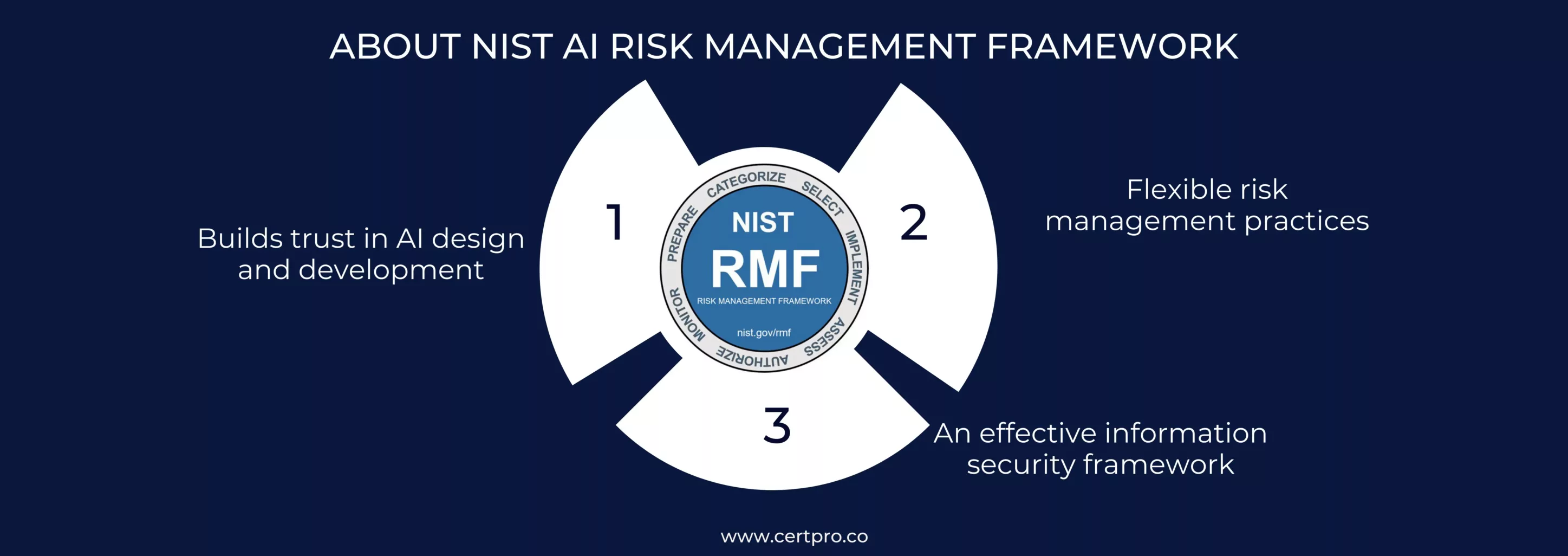
ABOUT ISO/IEC 42001 CERTIFICATION
It is an international standard for organizations that manage AI. It is the first AI management system standard. The standard provides guidelines regarding the establishment and execution of AI. Furthermore, the guidelines help maintain and improve the artificial intelligence governance system. The standard focuses on the ethics and transparency of the AI system. It also promotes trust among stakeholders and users.
Furthermore, the ISO/IEC 42001 standard covers multiple aspects of AI governance. It ensures your organization’s data privacy and security. However, it is a voluntary standard; organizations can incorporate it to certify compliance. The ISO/IEC 42001 standard outlines the requirements for establishing and implementing the AI management system with continuous monitoring. It applies to organizations that use products or services through AI systems. Therefore, incorporating the standards helps organizations systematically develop and utilize an AI-based system.
The standard ensures the implementation of controls for managing the AI system. Its purpose is to promote developing and using reliable and transparent AI systems. In addition, the standard emphasizes ethical principles and values when deploying AI systems. Further, it helps recognize and mitigate the risk related to AI execution. Moreover, the standard encourages organizations to ensure safe and user-affable AI design and deployment. It assists the organizations in adhering to compliance.
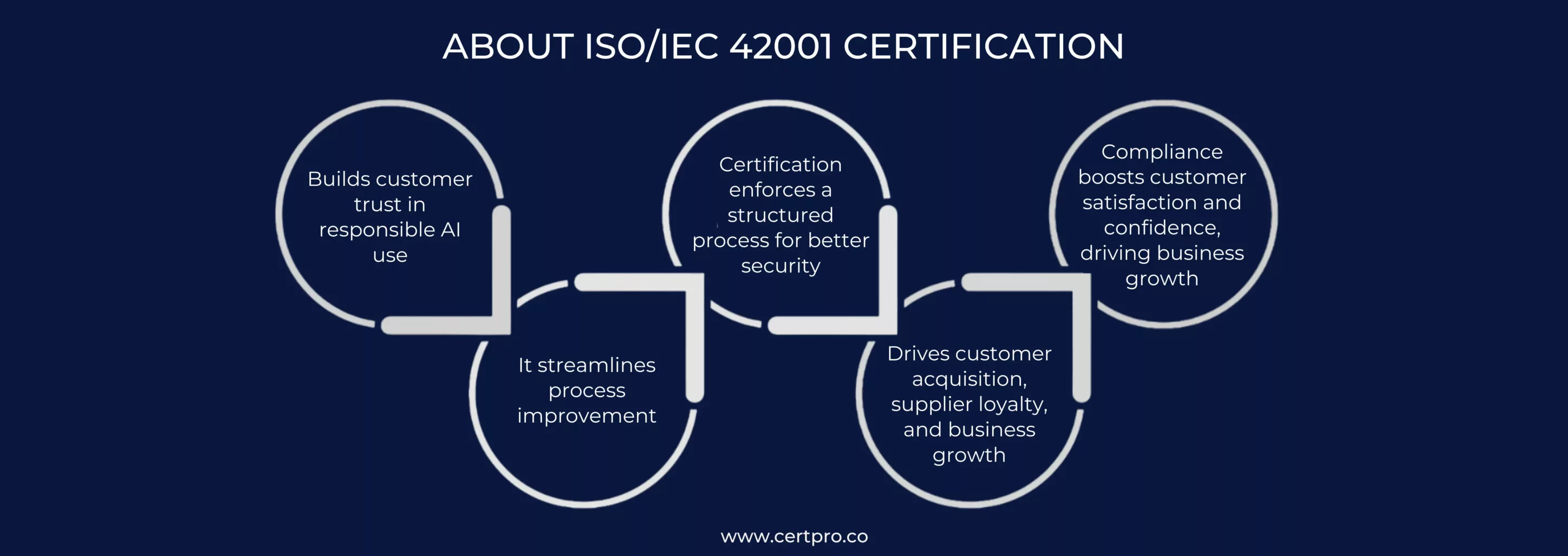
BENEFITS OF ISO/IEC 42001 CERTIFICATION
ISO/IEC 42001 certification suggested that the organization follows adequate AI management principles. The benefits are listed below:
- It creates trust in your customers regarding effective AI management principles.
- It offered a structural approach to improving the processes and the area of attention.
- The certification helps implement the structural approach to improve the process and maintain security.
- Compliance improves the customer’s satisfaction and confidence, which can lead to business growth.
- It enables a competitive advantage for customer acquisition and suppliers and grows the business.
ABOUT THE EU ARTIFICIAL INTELLIGENCE ACT
The European Union proposed a comprehensive legal framework for AI governance. Therefore, the EU AI Act is concerned with the rights and safety of its citizens. Again, the Act outlines the requirements of AI systems before they are deployed. Non-compliance with the Act can result in penalties. Furthermore, the Act assigns AI systems into three categories: applications that create an unacceptable risk, high-risk applications, and limited risk of AI systems.
Importance of the EU AI Act
The AI Act applies to companies that develop AI systems and market them for their services. It is essential for importers and distributors of AI systems in the European Union. The AI Act is mandatory for providers who offer AI service systems in the EU market. Hence, it applies to service providers within the European Union. The Act is a risk-based approach that mitigates risks according to their severity. In addition, it prohibits using certain AI practices that manipulate fundamental rights.
Furthermore, it ensures that the high-risk AI system meets the proper cybersecurity monitoring. The service providers inform the customers that they are interacting with AI to assist them. However, the Act does not restrict the use of AI but encourages maintaining security and informs customers about their AI applications.
In our daily lives, AI applications influence our online searches and monitor the details of our searches. Therefore, the application predicts our reading patterns and analyzes the data for specific advertisements. Thus, the EU AI Act determines the impact of AI on human lives.
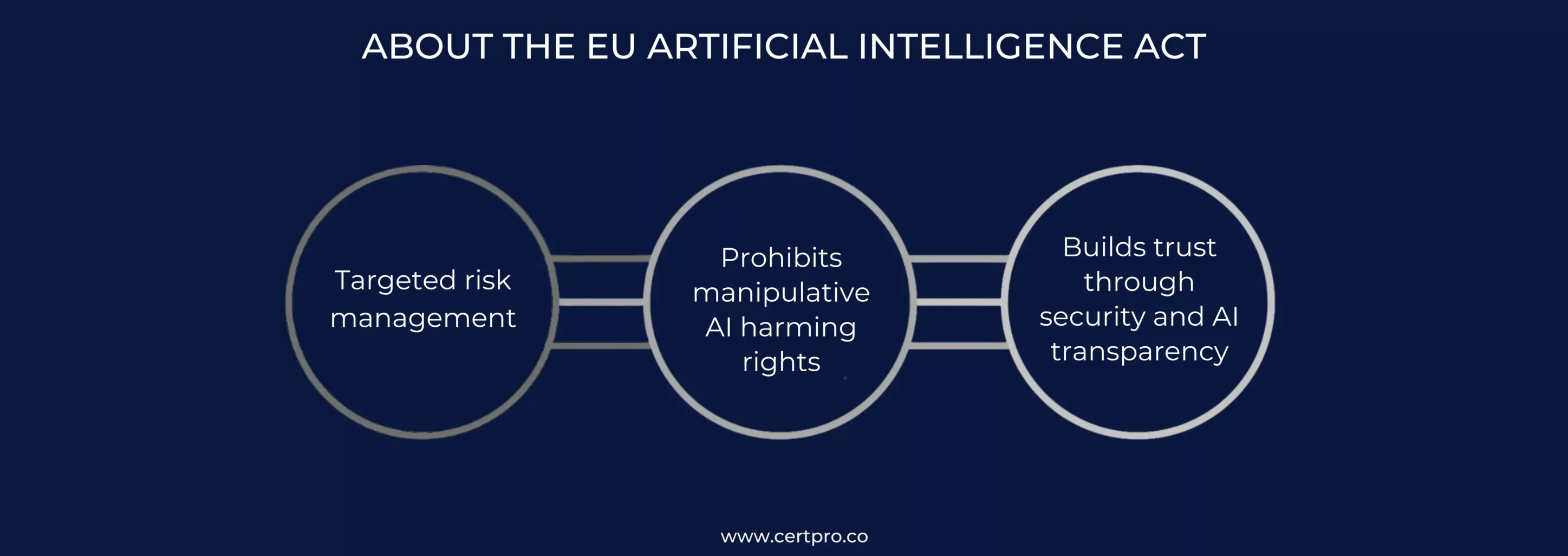
NIST AI RMF vs. ISO 42001 vs. EU AI Act: SIMILARITIES AND DIFFERENCES
The primary object of the three frameworks is to promote a responsible AI. Therefore, the main purpose of NIST AI RMF is to provide guidelines for risk management and consider the ethical aspect. On the other hand, ISO 42001 offers guidelines regarding AI management systems. Similarly, the EU AI Act is considering the specific compliance requirements. Thus, NIST AI RMF focuses on risk management, and ISO 42001 provides a structure for AI management. At the same time, the EU AI Act guides about the risk of an AI system.
Additionally, ISO/IEC 42001 is an international standard for the safe and effective use of AI in organizations. Like the ISO standard, NIST AI RFM is a voluntary standard that must be incorporated to maintain data security. However, the EU AI Act is mandatory for EU member states.
ALIGNING WITH THE FRAMEWORKS
At the initial stage, the organization should find out how their organization is willing to use AI for their business. In addition, organizations need to assess the associated risk with AI. It will help them recognize their challenges. Again, it is essential to recognize the desired outcomes of AI systems related to data processing, decision-making, and customer effects. Furthermore, organizations can develop a customized risk management strategy after considering their business framework and the use of AI. In this regard, training and awareness within the organization are crucial. In addition, implementing AI governance improves the organization’s transparency and helps develop business relationships.
FINAL THOUGHTS
AI is a modern technology that has multiple benefits. A certifiable AI management system is achieved through guidance. It ensures the specific standards for improving your organization’s AIMS. The prime aim of the Act and regulations is to utilize AI for better services and use them responsibly. However, the organization needs proper guidance and monitoring to guarantee data security. Finally, AI-related standards and regulations help structure the whole process of AI governance. Thus, they help enhance business growth and capabilities. They shape the overall operational process of your organization regarding AI-based systems. In addition, implementing such Acts and policies ensures the risk of data security related to AI.
FAQ
Why is it important to consider the AI governance policies and regulations?
The Act and regulations create a framework and monitor the process of artificial intelligence systems. It helps maintain the safety and security of your organization.
How Do NIST AI RMF, ISO/IEC 42001, and the EU AI Act Influence AI Governance?
All the above-stated laws and regulations provide guidance and structure for managing AI and algorithms. It audits the process of AI-based systems and finds out the relevant risks.
What Are the Best Practices for AI Governance in Organizations?
The Best practices for AI Governance are enclosed:
- Performing risk assessments.
- Creating clear policies and procedures.
- Executing robust data governance policies and practices.
- Encouraging clarity and explainability.
- Securing human supervision.
- Monitoring AI systems to comply with ethical concerns.
What is an Example of AI Governance?
The NIST AI RMF manages the risks associated with AI systems in the healthcare sector. The framework involves risk assessments, control implementation, and maintaining ethical and regulatory requirements.
What are the Pillars of AI Governance?
The primary pillars are:
1. Ethical and responsible AI development.
2. Data governance and privacy.
3. Transparency.
4. Risk management.
5. Monitoring and compliance.
6. Addressing potential harms

About the Author
NICOLENE KRUGER
Nicolene Kruger, Regional Manager in South Africa, is an experienced Legal Counsel with expertise in compliance and auditing. Her strategic, solution-driven approach aligns legal standards with business objectives, ensuring seamless adherence to regulations.
HOW DOES THE NIST CYBERSECURITY FRAMEWORK FUNCTION, AND WHY IS IT IMPORTANT?
Emerging cyber threats make cybersecurity an essential consideration for organizations handling and managing data. In this regard, the NIST cybersecurity framework applies to improving your cybersecurity program. It is a set of guidelines that helps improve your...
UNDERSTANDING ISO 42001: A GUIDE FOR RESPONSIBLE AI MANAGEMENT SYSTEMS
The invention of artificial intelligence (AI) has changed the operational processes of many industries. However, the rapid growth of technology increases ethical, security, and privacy-related concerns. Therefore, the International Organization for Standardization...
EUROPEAN UNION’S ARTIFICIAL INTELLIGENCE ACT: HOW THIS GROUNDBREAKING LAW AFFECTS YOUR BUSINESS
Nowadays, Artificial Intelligence (AI) is transforming our lives exceptionally well. AI is now streamlining healthcare services, providing virtual assistance, and fulfilling queries. Technologies have boons and curses. Similarly, AI creates many concerns about...

